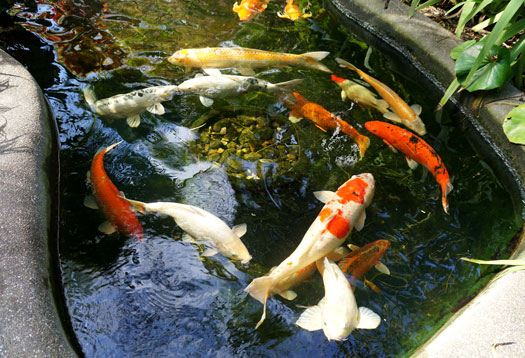- Your shopping cart is empty!
Can You Use Tap Water in a Koi Pond?

Of all the water sources available to freshwater fish keepers, the best will always be H2O that comes from a municipal treatment facility. Biochemically speaking, the most adequate water for a koi pond would come from natural Asian carp habitats. In the Niigata prefecture of Japan, rice paddies are irrigated by melted snow that seeps into the ground and becomes mineralized. This happens to be a region where koi breeding is a popular activity, and breeders are able to establish ponds that are semi-artificial. As you can imagine, hauling hundreds and even thousands of gallons of natural pond water to your garden isn’t reasonable, thus leaving conditioned water from the tap as your best option.
Untreated Tap Water Isn’t Koi-Friendly
Dumping koi into a bathtub filled with water from the faucet won’t kill them instantly, but it will only take a single feeding and a few hours for the ammonia levels to reach a lethal level in the absence of Nitrobacter to consume nitrates. You should make it a habit to double-check if the tap water you’re using for the pond has been conditioned. Make sure you always have plenty of conditioner on hand, as it’s one of the most essential koi pond supplies.
Treating and Conditioning Tap Water for Koi Ponds
Filling up a new garden pond with tap water is just one step out of many that must be taken before introducing koi. Unlike aquariums, you won’t be able to dechlorinate and condition the water before filling up the habitat, which is why it’s highly recommended to use a water conditioner like Seachem Prime:
This will dechlorinate and get rid of chloramines directly after filling. Since some water management districts use chlorine while others use chloramine as disinfecting agents, your best bet is to always use a conditioner that eliminates both. Testing for the absence of chlorine and chloramine is something you should do a few hours after conditioning so you know it’s safe to continue the establishment process.
Directly Adding Water from the Tap to the Pond
Let’s say your pond holds 1,000 gallons. When the time comes to perform a 25 percent water change, the ideal situation would be for you to treat and condition 250 gallons separately, but not all koi pond keepers have access to such large containers. In this case, it would be safe to add water right from the hose, but only after you’ve removed the old water from the pond and poured the adequate amount of conditioner. This is a relatively safe practice because koi won’t overdose on water conditioner.
Using Inline Dechlorinators
An alternative to using liquid conditioners for koi ponds is to attach an inline dechlorinating device to a tap water source in the garden. In essence, inline dechlorinators are cartridges filled with activated carbon that absorb and remove chlorine, chloramine, and other chemical compounds that are harmful to koi and other aquatic species. When one of these cartridges is installed, your life will be made easier in terms of water changes, but you should be mindful of its lifespan. To be on the safe side, some koi pond keepers are known to use water conditioners in addition to inline dechlorinators, and this is a prudent practice.
In addition to water conditioners and dechlorinators, there are several other supplies you’ll need to purchase to help you properly maintain your pond. Whether you need pond filters, beneficial bacteria, lighting, or any other koi pond supply, you can find what you’re looking for at Aquatic Warehouse. We’re located in Kearny Mesa, and you can also order what you need from our website and have it shipped directly to you. If you have any questions, feel free to give us a call today at 858-467-9297.
